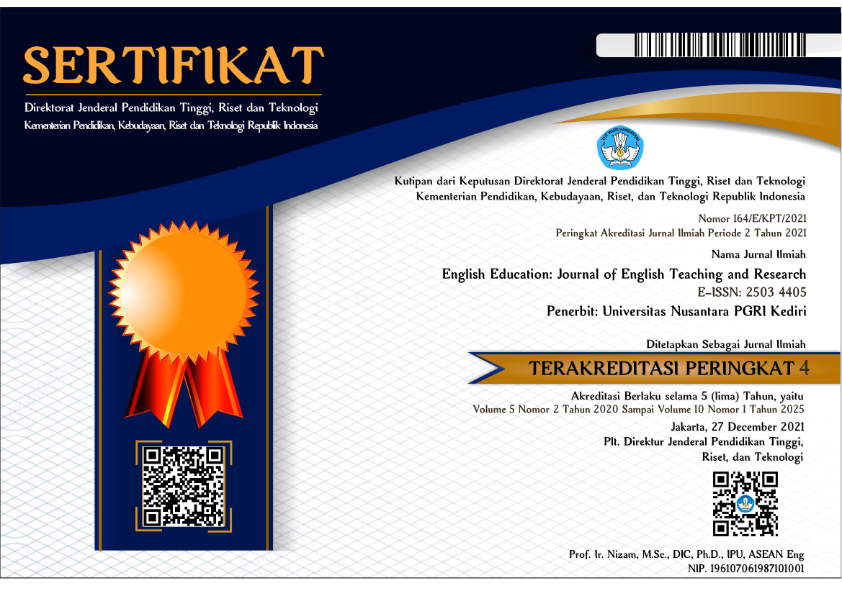An Analysis of EFL students' questions in Research on ELT class at University of PGRI Ronggolawe Tuban
DOI:
https://doi.org/10.29407/jetar.v6i1.15919Keywords:
Question, Higher Order Thinking Skills (HOTS), Lower Order Thinking Skills (LOTS), Classroom presentationAbstract
This research was conducted to analyze the questions used by EFL students in Research on ELT ( English Language Teaching ) Class at University of PGRI Ronggolawe Tuban. This research was conducted to know the types of questions applied by the students, the most dominant questions used based on the cognitive domains of Bloom’s taxonomy, and the students’ responses towards the questions. Descriptive qualitative research design was applied in the research. The subject of the study were the sixth semester students who took Research on ELT course. To collect the data, observation using Telegram application and interview were applied. The data were analyzed qualitatively to determine the cognitive level of each question according to revised Bloom’s taxonomy. The result of the data analysis showed that the students used empirical questions as the type of questions. The dominant question used based on the cognitive domains of Bloom’s taxonomy was Analyzing level or C4 which appeared 48%. It showed that HOTS questions were the most used at the classroom with the total 64%, while the LOTS questions only got 36%. The students claimed that they felt interested and glad to answer the questions. It can be concluded that the students of Research on ELT class had shown that they had ability to think critically.
Downloads
References
Anderson, et al. (2001) .A taxonomy for learning, teaching, and assessing: A revision of Bloom’s taxonomy of educational objectives. New York: Longman.
Bassham, Gregory, Irwin W., Nardone, H., & Wallace, J. (2005). Critical thinking: A student’s introduction. New York: McGraw Hill.
Bloom, B. S. (1956). Taxonomy of educational objectives: The classification of educational goals.Handbook 1; Cognitive Domain.
Brookhart, Susan M. (2010). How to assess higher-order thinking skills in your classroom.Virginia, USA: ASCD.
Daiek, Deborah & Anter, N. (2004). Critical reading for college and beyond. Boston:The McGraw-Hill Companies.
Dewi, Puspa. (2018). The analysis of questioning strategies used by lecturer in reading class, (Online),vol.2.(http://jurnal.unimus.ac.id/index.php/ELLIC/article/view/3546/, accessed on 23 August 2020.
Farmer, L. S. J. (2006). What is questioning? Paper presented at conference in world library and information congress: on questioning Seoul, Korea. Retrieved from http://www.ifla.org/Vifla72/index.htm. on 23 August, 2020.
Gabrielatos, C. A Question of functions: Teacher questions in the EFL classrooms. Retrieved from https://www.researchgate.net/publication/261708658_A_question_of_function_Teacher_questions_in_the_EFL_classroom on 23 August, 2020.
Krathwohl, D. R. (2002). A Revision of Bloom’s Taxonomy: An Overview. Theory into Practise, 41(4), 212-264.
Mishra, R., & Kotecha, K. (2016). Are we there Yet! Inclusion of higher order thinking skills (HOTs) in assessment. Journal of Engineering Education Transformations, 0(0), 2–5. https://doi.org/10.16920/jeet/2016/v0i0/85686
Mahfuzah, Afifatul, Jufri & Fitrawati. (2019). An Analysis of students’ ability to answer reading questions with HOTS. Journal of English Language Teaching, 8(1), 71 – 81. https://doi.org/10.24036/jelt.8i1.103222
Moore, B., & Stanley, T. (2013). Critical thinking and formative assessments: Increasing the rigor in your classroom. New York: Routledge.
Richards, J. C., & Lockhart, C. (2007). Reflective Teaching in Second Language Classrooms: Cambridge University Press.
Toni A., & Parse, F. (2013). The status of teacher’s questions and students’ responses: The case of an EFL Class. Academy Publisher, 4(3), 564- 569. DOI:10.4304/jltr.4.3.564-569.
Tsui, A.B. M. (1995). Introducing classroom interaction. London: Penguin.
Walsh, S. (2013). Classroom discourse and teacher development: Edinburgh University Press.
Widodo, Tri dan Sri Kadarwati. (2013). Higher order thinking berbasis pemecahan masalah untuk meningkatkan hasil belajar berorientasi pembentukan karakter siswa. Cakrawala Pendidikan. Vol. 42 (1). 161-171.
Downloads
Published
Issue
Section
License
Authors who publish with this journal agree to the following terms:
- Copyright on any article is retained by the author(s).
- The author grants the journal, the right of first publication with the work simultaneously licensed under a Creative Commons Attribution License that allows others to share the work with an acknowledgment of the work’s authorship and initial publication in this journal.
- Authors are able to enter into separate, additional contractual arrangements for the non-exclusive distribution of the journal’s published version of the work (e.g., post it to an institutional repository or publish it in a book), with an acknowledgment of its initial publication in this journal.
- Authors are permitted and encouraged to post their work online (e.g., in institutional repositories or on their website) prior to and during the submission process, as it can lead to productive exchanges, as well as earlier and greater citation of published work.
- The article and any associated published material is distributed under the Creative Commons Attribution-ShareAlike 4.0 International License








 Article template
Article template



